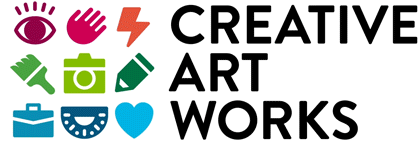Building Communities
During two joyful culminating events, every student was given a change to practice public speaking.
Our young designers demonstrated a sophisticated understanding of urban design...
… and they were eager to provide guided tours of their model neighborhoods.
Some of the 820 “art-to-go” bags distributed to students as part of a Cultural After-School Adventure program called, Community Works: Design + Build.
“Art-to-Go”
Over the course of the pandemic, Creative Art Works distributed over 820 “art-to-go” bags. Hundreds of these bags were packed by our staff and teaching artists, along with youth apprentices, and delivered to students and parents just in time for Spring Break. The bags contained a wealth of art materials, including colored pencils, markers, pastels, crayons, scissors, tape, glue sticks, air clay, felt sheets, origami paper, pipe cleaners, drawing pads, and balsa wood blocks. After many months of virtual learning and digital art, students welcomed a chance to look away from their screens and create art they could hold in their hands.
Given the chance to envision a more livable neighborhood, many students focused on amenities such as parks, pools, and playgrounds.
Community Works: Design + Build
The distribution of materials preceded the offering of a free remote art-making program, called Community Works: Design + Build, which ran every day during Spring Break. A combination of urban design and mixed media arts, this program invited young people to imagine ways they might create their own neighborhoods. There were four sections, including two sections for students in grades K–2 and 3–5 in West Harlem; and classes taught in English and Spanish for middle school students in The Bronx. Many parents and siblings also joined in.
“What makes a neighborhood a good place to live?”
That is the question at the heart of urban design and this project-based program encouraged students to think holistically and embrace complexity during regular class discussions. There is no single correct answer. Building a model of an ideal neighborhood further challenged students to draw on multiple modalities of learning, problem solving, and abstract thinking. How do you communicate something as concrete (pun intended) as a school or apartment building using materials such as construction paper, pipe cleaners and tissue paper?
The Final Reveal
Our young designers were eager to provide guided tours of their model neighborhoods during two truly joyful culminating events over Zoom. Thoughtful amenities included parks, playgrounds, schools, dog runs, lots of pizza parlors, and even a swimming pool with a sandy beach so bathers could dry off after a swim. Many students showed a sophisticated understanding of need for public works, such as housing, mass transit, and clean water.
“Me and Stan got this crazy idea. We thought we could combine our communities so it would be very big. Our roads would connect and we would have a lot of houses, and Stan has a playground that combines with my little park.”
Elaina’s “crazy idea” brought to life.
This Creative Art Works program is supported, in part, by public funds from the New York City Department of Cultural Affairs and the Cultural After-School Adventures (CASA) Initiative in partnership with the City Council and Council Members Mark Levine and Oswald Feliz.






